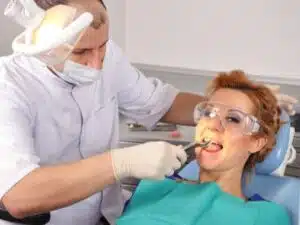There are only a handful of orthodontic emergencies, most of which can be treated at home. So, what does one do when they’re faced with an emergency? In this blog, our orthodontist in Newburgh will tell you how to prepare yourself for any unforeseen circumstances!
Signs You Need Orthodontic Emergency
Sometimes you can’t tell if you need an orthodontic emergency until the situation has become severe. Here are telltale signs that you need it.
Severe pain or discomfort
Severe pain or discomfort is a result of a number of orthodontic issues, including:
- Loose or broken brackets or wires: A loose or broken bracket or wire can irritate the soft tissues in your mouth, causing pain or discomfort.
- Protrusion of broken wire: A broken wire can stick out and irritate the soft tissue in the mouth, causing pain or discomfort.
- Ulceration or injury to the tongue, lips, or cheeks caused by orthodontic appliances: Brackets and wires can rub against the soft tissues in your mouth, causing ulcers or injuries.
- Lost or loose spacers: Spacers are small rubber bands that are placed between your molars to create space for orthodontic treatment. If a spacer becomes loose or falls out, it can cause pain or discomfort.
- Damage to the jaw joint: Orthodontic treatment can put extra stress on your jaw joint, causing pain or discomfort.
Broken or loose bracket wire
A broken or loose bracket or wire can bring different issues that require orthodontic emergency care, including:
- Irritation or injury to the soft tissues in your mouth: A broken or loose bracket or wire can rub against the soft tissues in your mouth, causing irritation, ulcers, or injuries.
- Misalignment of your teeth: A broken or loose bracket or wire can cause your teeth to shift out of place, disrupting your orthodontic treatment and potentially causing bite issues or other problems.
- Uncomfortable or painful: A broken bracket or wire can be uncomfortable or painful, especially if it is poking into the soft tissue in your mouth.
Lost or damaged retainer
If you lose or accidentally damage your retainers, it can cause several issues that need orthodontic emergency care, including:
- Teeth shifting out of place: Retainers are used to keep your teeth in the correct position after orthodontic treatment. Without a retainer, your teeth may shift out of place, disrupting your treatment and potentially causing bite issues or other problems.
- Difficulty speaking or eating: A lost or damaged retainer can make it difficult to speak or eat properly, causing discomfort or embarrassment.
- Relapse of orthodontic treatment: Retainers are used to prevent the relapse of orthodontic treatment. If not worn, the teeth can shift back to their original position, which can result in a relapse of orthodontic treatment and cause additional cost and time.
Lost filling or crown
A lost filling or crown can cause a lot of issues where orthodontic emergency care is needed, including:
- Pain or discomfort: A lost filling or crown can expose the sensitive nerves in your tooth, causing pain or discomfort.
- Tooth sensitivity: A lost filling or crown can also cause tooth sensitivity, especially when eating or drinking hot or cold foods and liquids.
- Increased risk of tooth decay: A lost filling or crown can leave the tooth exposed to bacteria, increasing the risk of tooth decay.
- Impact on Orthodontic treatment: A lost filling or crown can also affect the orthodontic treatment. The missing filling or crown can cause tooth movement or shifting, which may disrupt the progress of the treatment.
Tooth Loss
Tooth loss can cause multiple problems that require orthodontic emergency care, such as:
- Pain or discomfort: A lost tooth can cause pain or discomfort, especially if the surrounding gums are inflamed or infected.
- Impact on Orthodontic treatment: A lost tooth can also affect the orthodontic treatment; the missing tooth can cause tooth movement or shifting, which may disrupt the progress of the treatment.
- Difficulty speaking or eating: A lost tooth can make it difficult to speak or eat properly, causing discomfort or embarrassment.
- Affecting appearance: A lost tooth can also affect the appearance of your smile and make you self-conscious.
- Impact on overall oral health: The loss of a tooth can also affect the overall oral health, as the missing tooth can cause changes in bite and jaw alignment, leading to the potential loss of other teeth and other oral health problems.
Protruding broken wire
There are many concerns caused due to protrusion of a broken wire that need orthodontic emergency assistance, including:
- Irritation or injury to the soft tissues in your mouth: A protruding wire can rub against the soft tissues in your mouth, causing irritation, ulcers, or injuries.
- Pain or discomfort: A protruding wire can be uncomfortable or painful, especially if it is poking into the soft tissue in your mouth.
- Impact on Orthodontic treatment: A protruding wire can also affect orthodontic treatment. It can cause tooth movement or shifting, which may disrupt the progress of the treatment.
- Difficulty speaking or eating: A protruding wire can make it difficult to speak or eat properly, causing discomfort or embarrassment.
How to Handle Orthodontic Emergency Care at Home
Here is a guide on how to handle orthodontic emergencies at home:
#1 – Call your orthodontist
The first step in handling an orthodontic emergency is to call your orthodontist and schedule an emergency appointment. They will be able to diagnose the issue and provide appropriate treatment to alleviate your symptoms.
#2 – Control any bleeding
If you are experiencing bleeding in your mouth, use a clean piece of gauze to apply pressure to the area. If the bleeding does not stop, seek immediate medical attention.
#3 – Relieve pain and discomfort
If you are experiencing pain or discomfort, take over-the-counter pain medication such as ibuprofen or acetaminophen. You can also use orthodontic wax or a wet cotton swab to cover any sharp or protruding wires or brackets.
#4 – Handling a lost retainer
If you have lost your retainer, try to find it and keep it in a safe place. If you are unable to find it, contact your orthodontist to schedule an appointment to have a new one made.
#5 – Dealing with a lost filling or crown
If you have lost a filling or crown, try to find it and keep it in a safe place. If you are unable to find it, contact your orthodontist and dentist as soon as possible to schedule an appointment to have a new one made.
#6 – Handle a lost or broken separation device
If you have lost or broken your separation device, contact your orthodontist to schedule an appointment to have a new one made.
#7 – Have a protruding wire
If you have a protruding wire, use orthodontic wax or a wet cotton swab to cover the wire and make it less irritating. If the wire cannot be covered, use a clean pair of scissors or nail clippers to clip the protruding wire as close to the bracket as possible.
#8 – Experiencing a broken or loose bracket or wire
If you have a broken or loose bracket or wire, use orthodontic wax or a wet cotton swab to cover the wire and make it less irritating. If the bracket or wire cannot be covered, contact your orthodontist to schedule an emergency appointment.
It is important to remember that while these steps may provide temporary relief, it is still necessary to see an orthodontist as soon as possible to fully address the problem and avoid any long-term damage to your teeth or gums.
Partner with Northeastern Braces for Your Orthodontic Emergency Care Needs
If you experience an orthodontic emergency in Newburgh, we encourage you to visit Northeastern Braces as soon as you can. You can be more prone to discomfort and delay your treatment plan if you postpone your trip.
We are located in Newburgh and Bronx, NY, and we are just one call and message away from answering your inquiries and concerns.
« Clear Braces: A Popular Orthodontic Treatment Option
